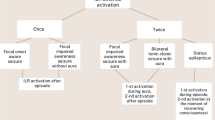Abstract
Introduction: The Insertable Loop Recorder (ILR) has emerged as an important new tool in the diagnostic armamentarium for patients with syncope.
Methods and Results: A case report illustrates how the ILR unexpectedly led to the diagnosis of seizure as the explanation for a man's recurrent, but infrequent episodes of sudden loss of consciousness.
Conclusions: This case raises the possibility that the development of implantable recording devices which monitor physiologic parameters other than cardiac rhythm (eg. brain, nerve or muscle activity) may provide the long-term monitoring capability needed to improve the diagnostic yield for conditions, such as seizures, which occur infrequently.
Similar content being viewed by others
References
Kapoor WN. Evaluation and outcome of patients with syncope. Medicine (Baltimore) 1990;69:160-175.
Sra JS, Anderson AJ, Aheikh SH, et al. Unexplained syncope evaluated by electrophysiologic studies and head-up tilt testing. Ann Intern Med 1991;114:1013-1019.
Krahn AD, Klein GJ, Yee R, Norris C. Final results from a pilot study with an implantable loop recorder to determine the etiology of syncope in patients with negative noninvasive and invasive testing. Am J Cardiol 1998;82:117-119.
Author information
Authors and Affiliations
Rights and permissions
About this article
Cite this article
Simpson, C.S., Barlow, M.A., Krahn, A.D. et al. Recurrent Seizure Diagnosed by the Insertable Loop Recorder. J Interv Card Electrophysiol 4, 475–479 (2000). https://doi.org/10.1023/A:1009804429745
Issue Date:
DOI: https://doi.org/10.1023/A:1009804429745




